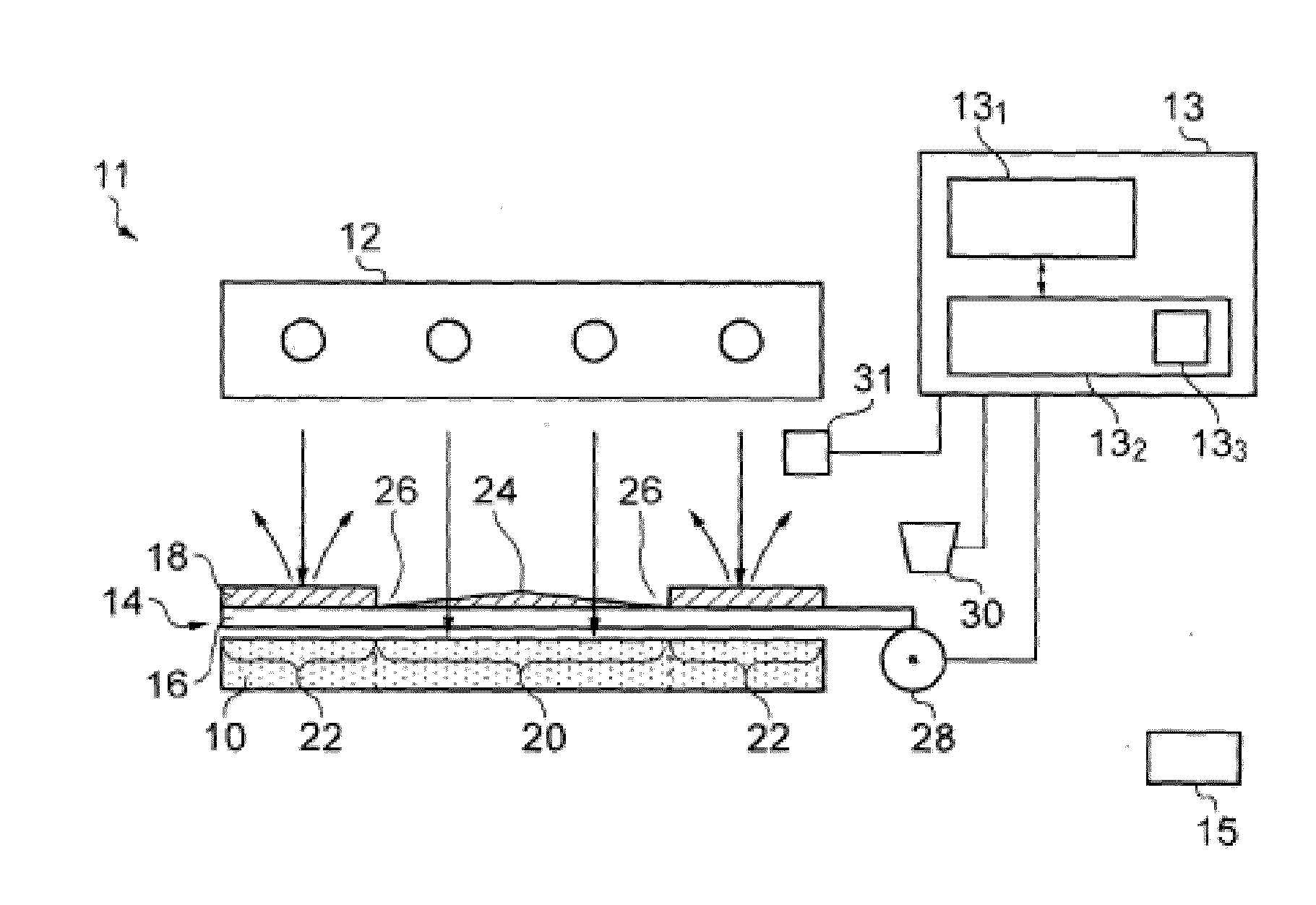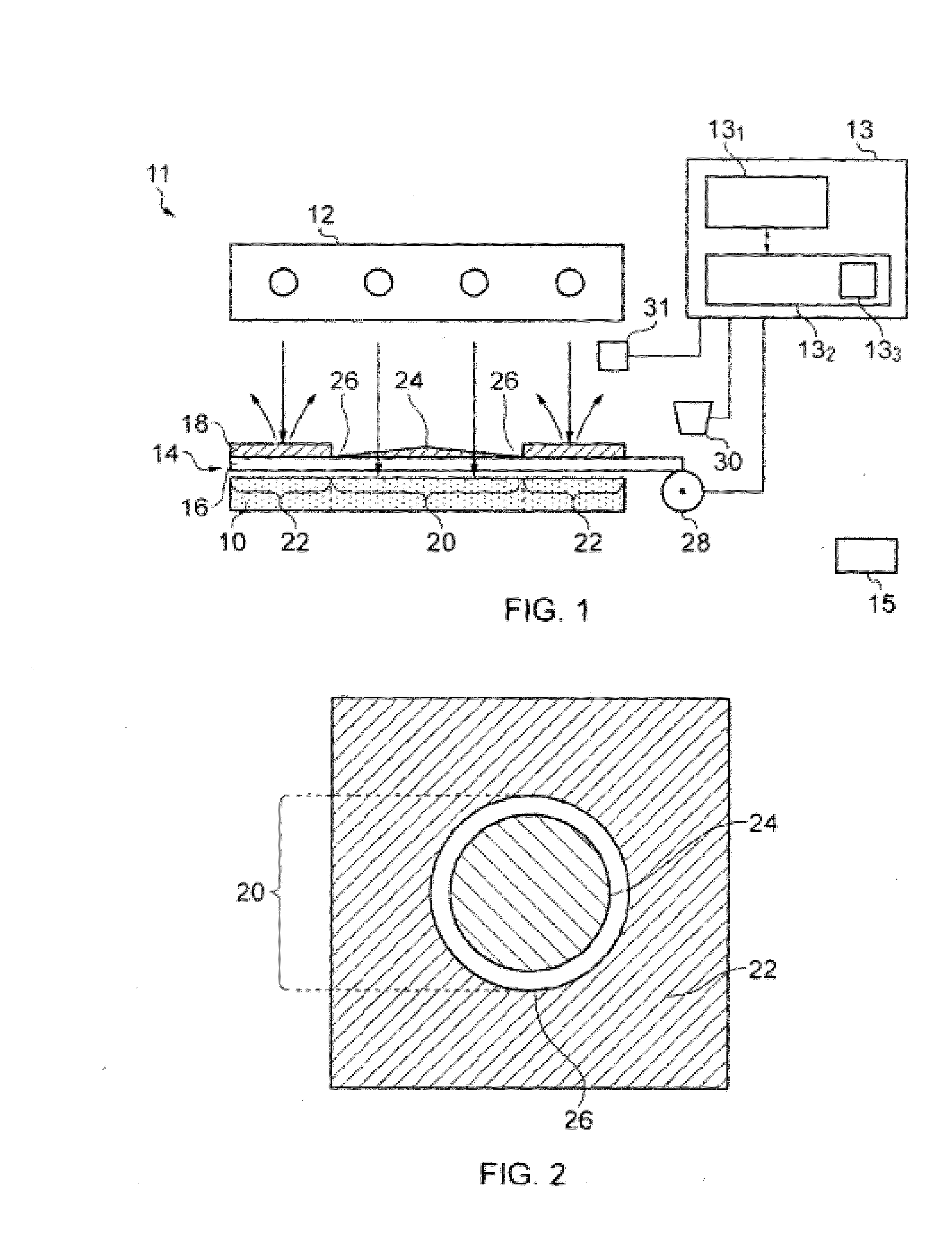Methods and Apparatus for Selectively Combining Particulate Material
a technology of selective combining and particulate material, which is applied in the direction of additive manufacturing process, electric/magnetic/electromagnetic heating, manufacturing tools, etc., can solve the problems of preventing the progress of the build, poor part quality, and failure of the build, so as to increase reduce the energy provided to the sintered portion
- Summary
- Abstract
- Description
- Claims
- Application Information
AI Technical Summary
Benefits of technology
Problems solved by technology
Method used
Image
Examples
first embodiment
[0106]FIG. 1 illustrates apparatus for sintering particulate material in which an obscurer 14 (i.e. a mask) is provided for selectively obscuring the radiation provided by the source 12 on the surface portion of the layer 10 to thereby vary the intensity of the radiation incident on the surface portion of the layer 10. The obscurer 14 comprises a radiation transmissive substrate 16, such as a glass plate, which carries a varying amount of radiation reflective material 18, such as aluminium oxide. The amount and pattern of material 18 deposited on the substrate may be varied to selectively vary the intensity of radiation incident on the surface portion of the layer 10, as will be described hereinafter.
[0107]Referring also to FIG. 2, the surface portion of the layer 10 is logically divided by the obscurer 14 into a number of areas including a combination portion 20, which is to be exposed to radiation to combine the particulate material, and a non-combination portion 22 which is to be...
second embodiment
[0115]FIG. 3 illustrates apparatus for combining particulate material, in which corresponding elements are given corresponding reference numerals. The apparatus of FIG. 3 is similar to that shown in FIG. 1, except that instead of the reflective material 18 being deposited onto a substrate 16, the reflective material 18 is deposited, using the printing head 30, directly onto the surface portion of the layer 10 of particulate material.
[0116]In the apparatus of this embodiment, the printing head 30 is again controlled by the controller 13 which controls both the movement of the head 30 across the surface of the layer 10 and the rate of deposition of reflective material 18 onto the layer 10. Again, real time measurement of the surface temperature of the layer 10 may be carried out using a temperature measurement device 31, for example, a pyrometer P or thermal imaging camera, the temperature measurement being used by the controller 13 to determine the amount of reflective material 18 to...
fourth embodiment
[0120]FIG. 5 illustrates apparatus for combining particulate material which is similar to the embodiments described above and in which corresponding elements have been given corresponding reference numerals.
[0121]The apparatus of FIG. 5 is most similar to the apparatus of FIG. 3 in that material is deposited directly onto the surface portion of the layer 10 of particulate material. However, according to the fourth embodiment, the material is a radiation absorbent material 50, for example a material including carbon black in powder form. In use, radiation provided by the radiation source 12 is absorbed by the radiation absorbent material 50 where it is present on the surface, causing the radiation absorbent material 50 to heat up. Heat from the radiation absorbent material 50 is transferred to the underlying particulate material raising the temperature of individual particles of the particulate material. As the particles are heated to a temperature approaching their melting temperatu...
PUM
| Property | Measurement | Unit |
|---|---|---|
| distance | aaaaa | aaaaa |
| height | aaaaa | aaaaa |
| temperature | aaaaa | aaaaa |
Abstract
Description
Claims
Application Information
 Login to View More
Login to View More - R&D
- Intellectual Property
- Life Sciences
- Materials
- Tech Scout
- Unparalleled Data Quality
- Higher Quality Content
- 60% Fewer Hallucinations
Browse by: Latest US Patents, China's latest patents, Technical Efficacy Thesaurus, Application Domain, Technology Topic, Popular Technical Reports.
© 2025 PatSnap. All rights reserved.Legal|Privacy policy|Modern Slavery Act Transparency Statement|Sitemap|About US| Contact US: help@patsnap.com



